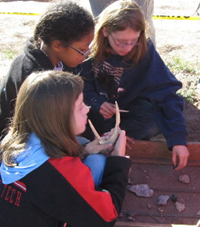
Native knapping kits. Girl Scouts examine a deer antler, stone, and other materials used by Native peoples for making tools.  |
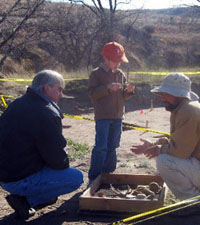
Question and answer time. The public education tours included a chance to handle artifacts and talk to archeologists.  |
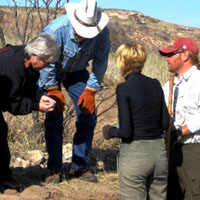
Clues in the dirt. Even the tiniest materials, such as stone flakes, may be evidence of activities in the past, such as knapping tools.  |
|
During fieldwork for the Landis project, TRC held multiple open house sessions for the public, and several educational outings were hosted specifically for area Girl Scouts and their families. Visitors had the chance to visit the Landis Project sites during active excavations. More than 200 visitors participated in these events and got a close-up view of the investigations.
TRC archeologists Mike Quigg and Paul Matchen of Austin along with geoarchaeologist Charles Frederick of Comanche, Texas, led visitors on walking tours through the site, highlighting areas of particular interest and explaining what is known of the prehistory and past climate of the area (the what, when, why, and how).
The staff encouraged the young girls to ask questions about the sites and about the different jobs that archeologists and geoarcheologists do. Examples of artifacts commonly found in the Texas Panhandle—projectile points, bison bones, pottery sherds, etc.—were displayed and passed around. Special exhibits featured burned rocks used in prehistoric cooking events and a stone-tool manufacturing kit with antler billets, chert flakes, and finished chipped-stone tools. Some of the young group even tried their hands at screening dirt. In the process, the Girl Scouts got a “hands on” feel for archaeology in their own backyard, and TRC enjoyed the opportunity to visit with the local residents about the history of the region in which they live.
To bring the project to a larger audience, TRC made a poster board presentation of the Landis investigations at the Society of Historic Archeology 2008 annual meetings in Albuquerque, New Mexico. That poster display was then presented to the Girl Scouts as a reminder of their experiences as burgeoning archeologists. |
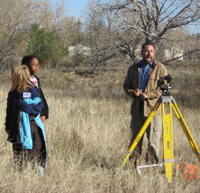
Tools of the trade. TRC archeologist Paul Matchen explains techniques and equipment used by archeolgists for mapping and taking measurements in the field.  |
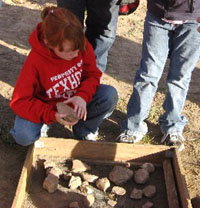
Hot rock cooking? Scouts examine burned rocks that may be the remains of hearths used by Native peoples for cooking and heating. |
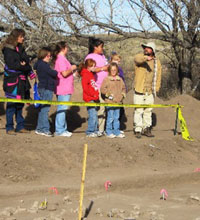
The big picture. Scouts check out the large block excavation units. The clusters of rocks and artifacts marked with pink flags are activity areas where tool making and cooking took place in the campsite  |
|